Radeon RX 590 vs. RX 580 vs. GeForce GTX 1060
Today we're checking out the new-ish Radeon RX 590 and on hand for testing we have the XFX Radeon RX 590 'Fatboy'. This is technically a new GPU, but kind of not new at the same time. What nosotros take here is Polaris 20 XT on the 12nm FinFET procedure, and this small change translates into slightly better clock speeds.
There are no boosted stream processors, no fancy GDDR6 retention, or even GDDR5X retentiveness for that matter. So in essence nosotros're getting the aforementioned RX 580 with a 15% overclock, at least when comparing the reference clock speeds. However since about entry-level RX 580 models are clocked at 1380 to 1410 MHz, this gives the RX 590 a 10-12% clock frequency reward out of the box. Then there's the college-end models like the Gigabyte Aorus RX 580 XTR, which we utilise for testing, and that particular model comes clocked at 1425 MHz, reducing the RX 590'southward clock speed advantage to 8%.
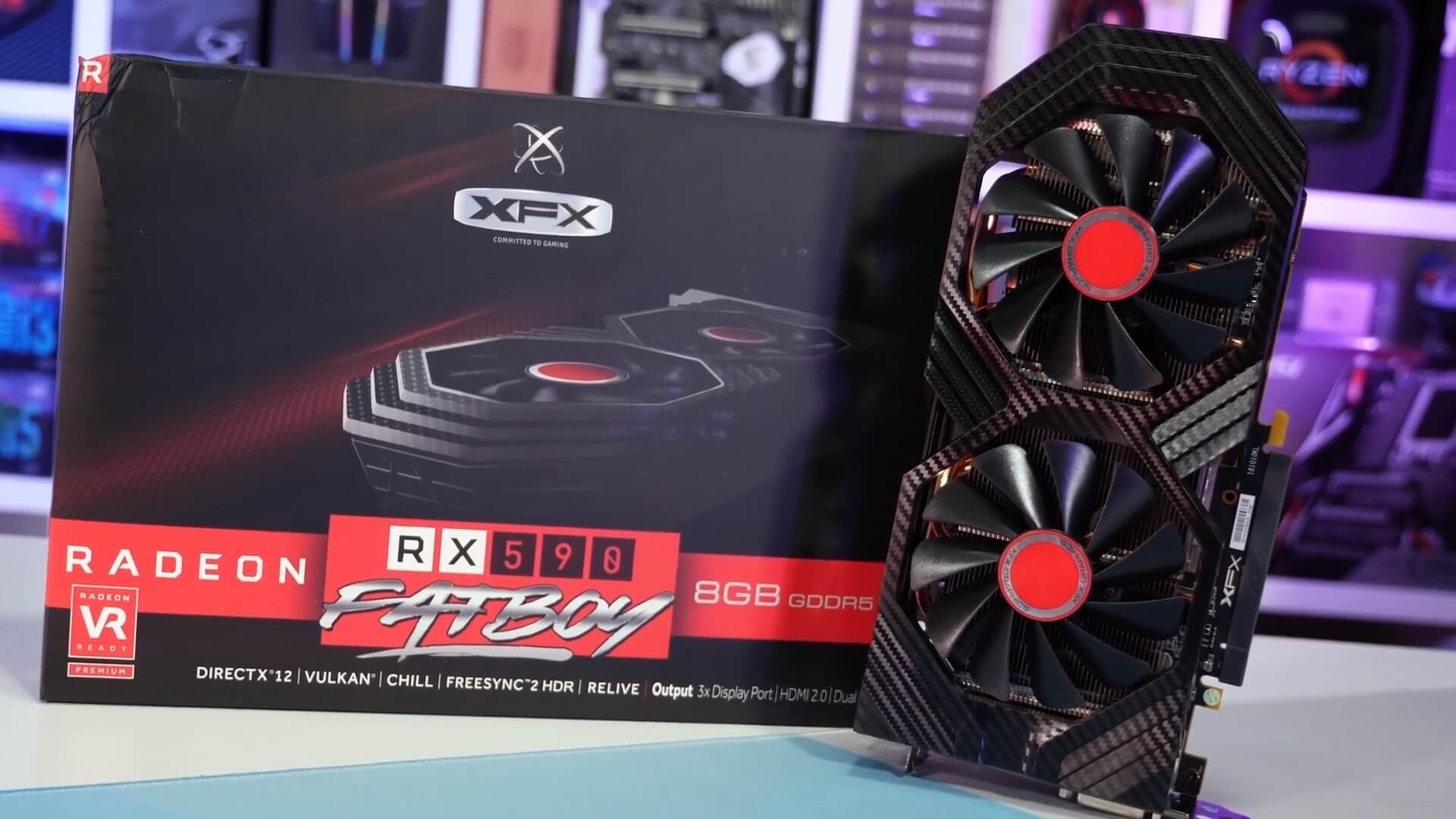
Information technology'due south important to clarify this context because for testing we felt it would be misleading to compare the RX 590 with a base model RX 580 using the AMD reference clocks. AMD has sullied this launch past pricing the RX 590 at $280, which is a considerably premium for this slightly overclocked RX 580. Meanwhile, the RX 580 comes in at around $230 (MSRP), and right now tin can be institute for as fiddling as $200.
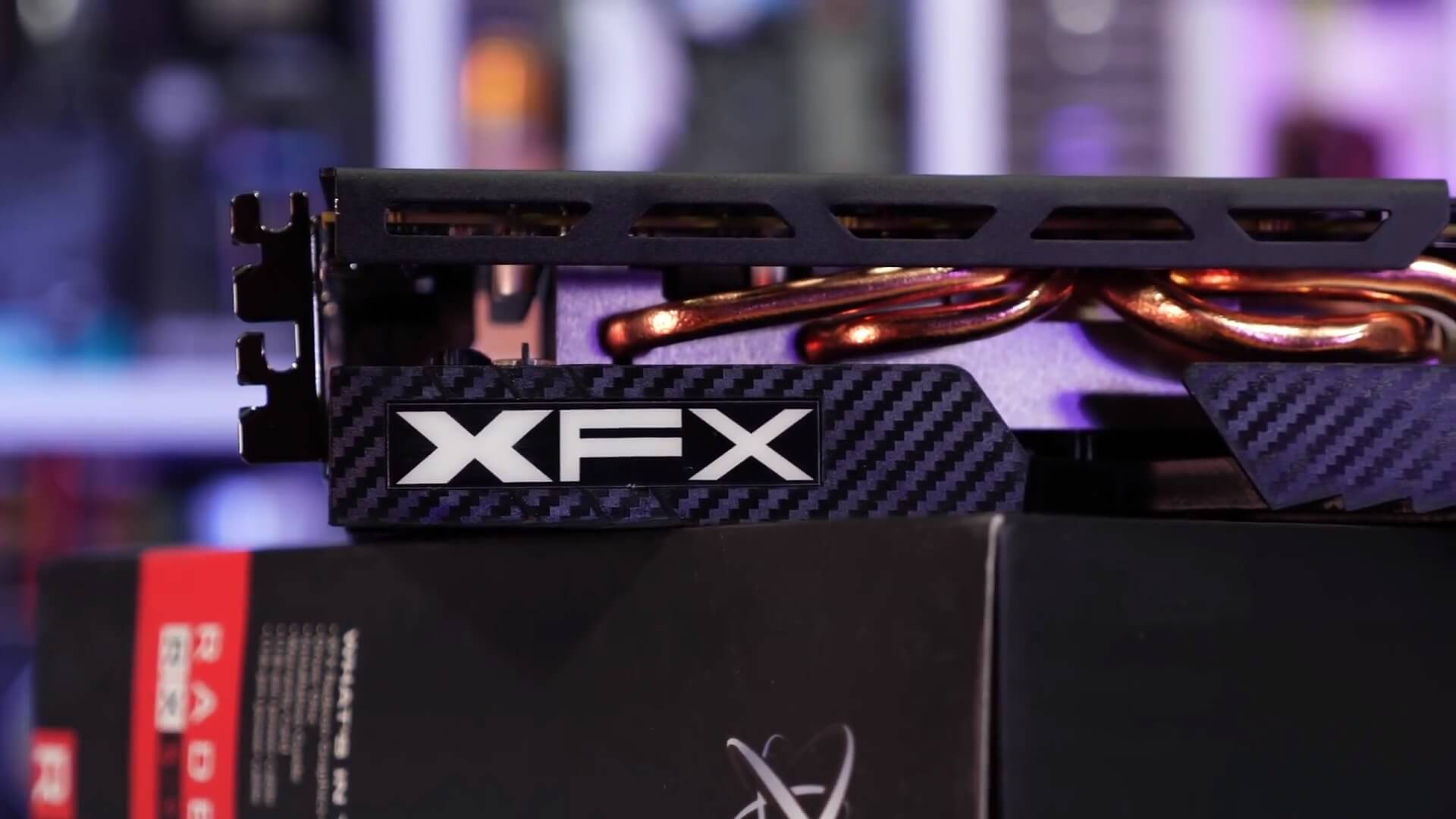
AMD claims up to a 12% operation boost over a reference clocked RX 580, yet they remember that means they tin increment the MSRP by 22%, so this should be interesting, or upsetting depending on your position.
For testing we're using the XFX Radeon RX 590 Fatboy and information technology will exist compared to the Gigabyte Aorus RX 580 XTR and MSI GeForce GTX 1060 Gaming 10+. Nosotros were unable to exam the usual big battery of GPUs for this review, and so y'all'll detect the absense of more affordable models such equally the RX 570 and 3GB GTX 1060, though we included as many results as we could. If you don't heed extrapolating nonetheless, previous tests will give you enough of straight GPU comparisons if that'due south what you want (RX 590 excluded of course).
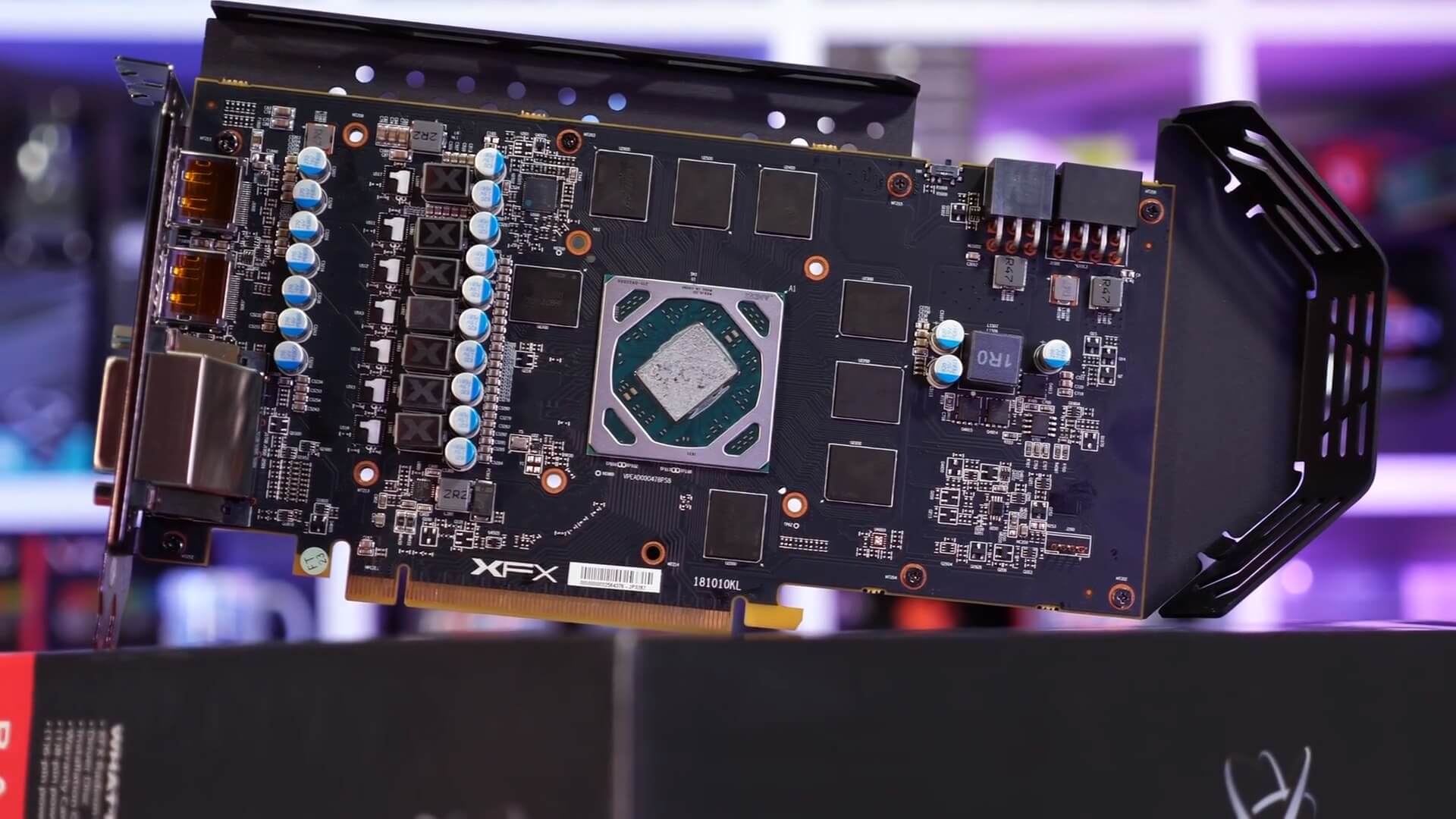
Our benchmarks were ran using a Core i7-8700K clocked at 5GHz and 32GB of Vengeance DDR4-3400 retentivity. In total we take results for 21 games at two resolutions, 1080p and 1440p just the commentary will exist focused on 7 of the more recently released titles.
Benchmarks
Get-go up we have Battlefield V results (don't miss our recent RTX ray tracing test!) and here the XFX 590 was seven% faster than the Aorus 580 XTR, taking the average frame charge per unit from 85 fps to 91 fps. This is the kind of margin nosotros were expecting, though that difference is reduced to merely iii% at 1440p. On the upside, the RX 590 was a total 20% faster than our GTX 1060 card.
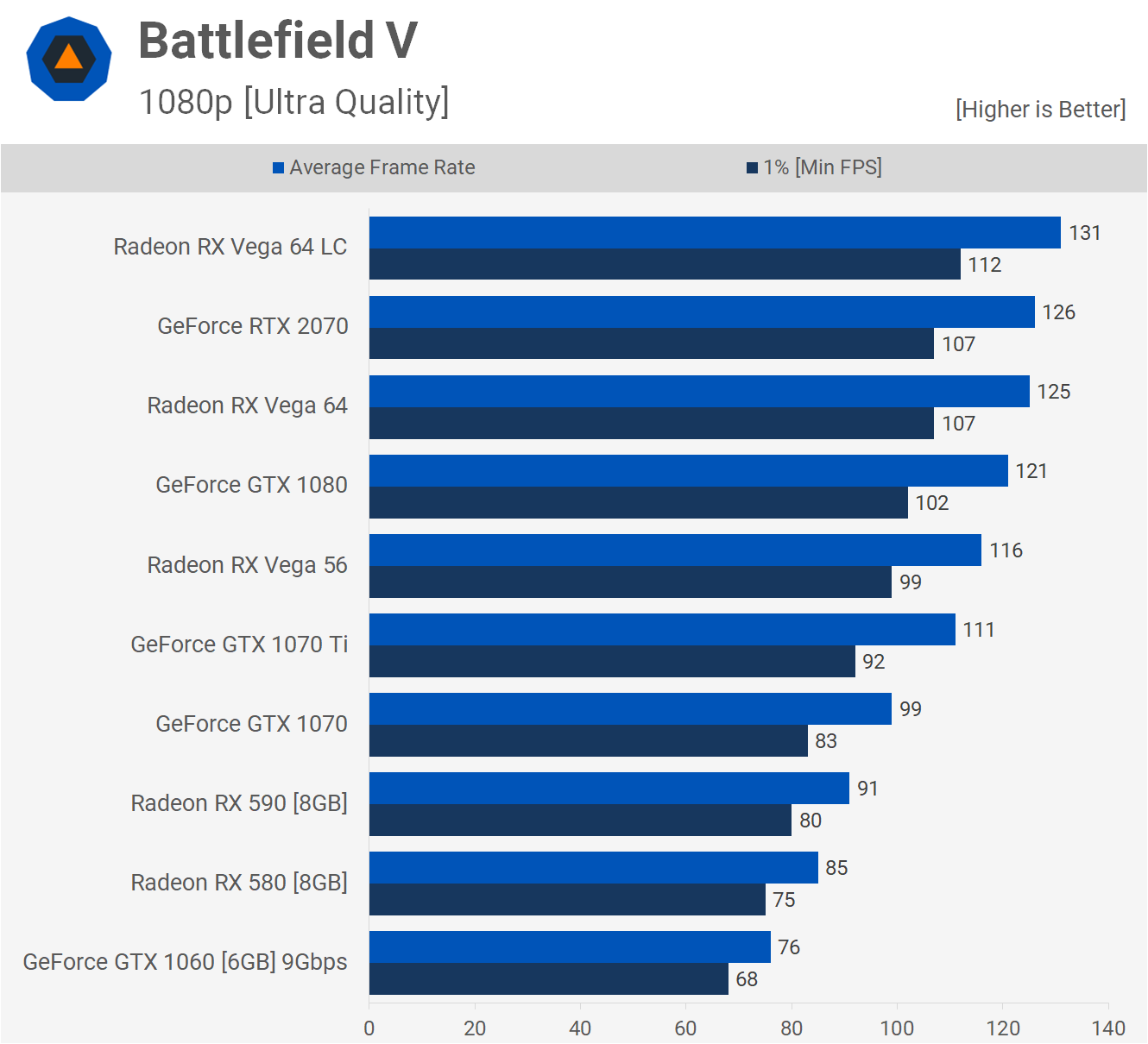
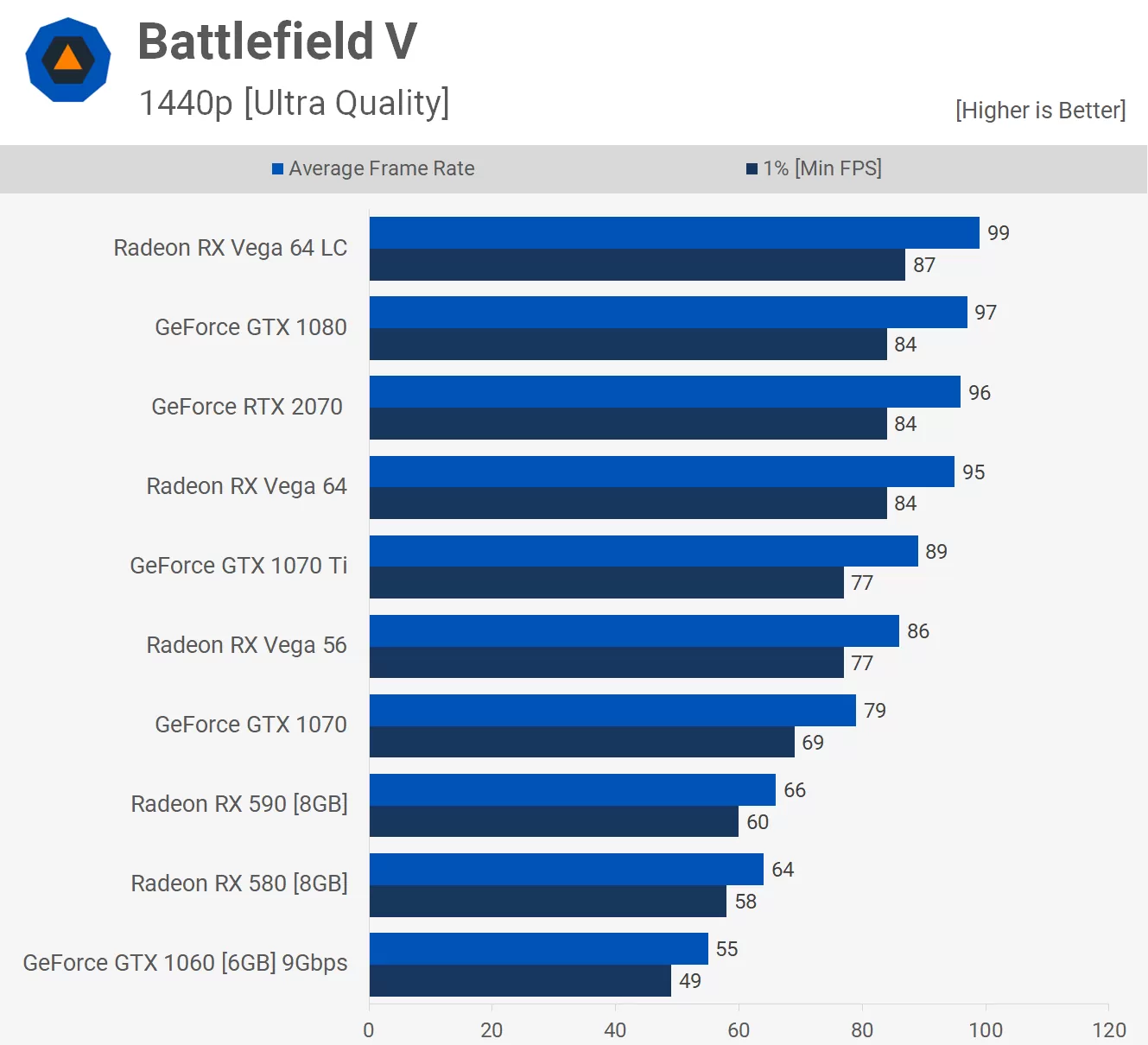
Strange Brigade results at 1080p have the RX 590 performing five% above the 580 and sixteen% faster than the GTX 1060. At 1440p we see the aforementioned 5% margin, here the 590 provided an additional 3 fps over the Aorus RX 580 XTR, not exactly exciting stuff is it?
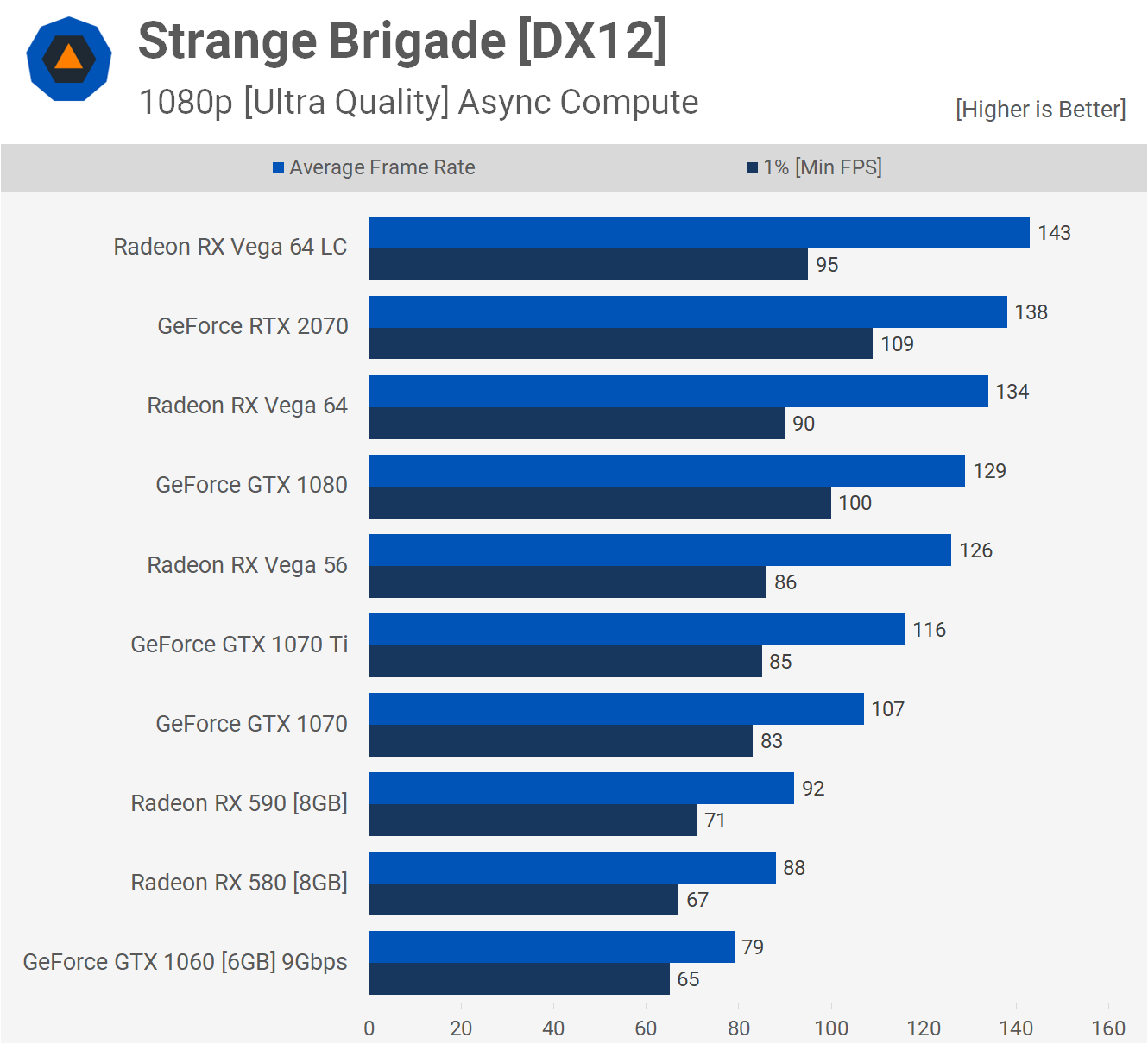
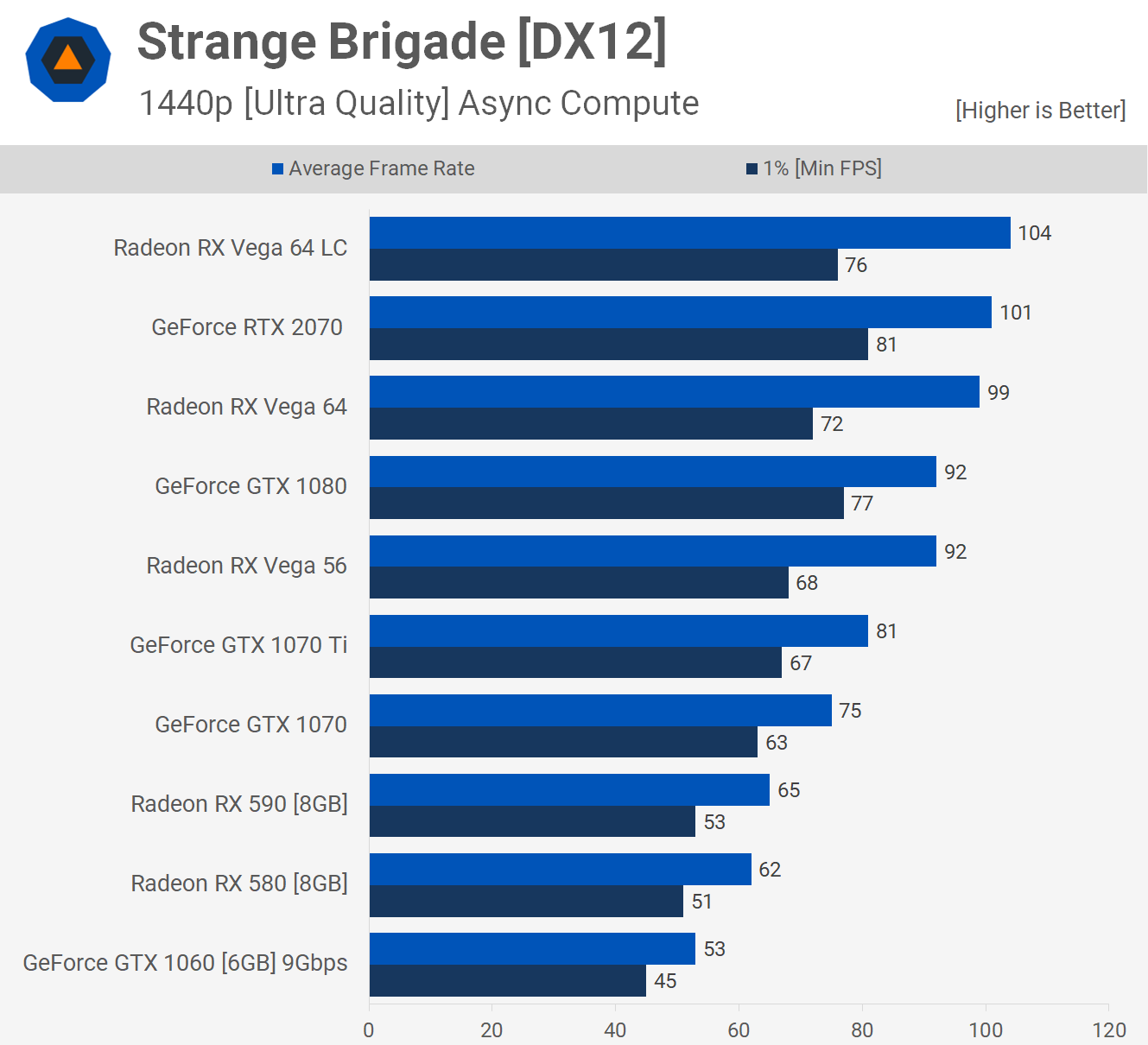
The Assassin's Creed series has been a fleck brutal for AMD recently and Odyssey is no dissimilar. Hither the 580 and 590 are easily beaten by the GTX 1060 at 1080p. We notice a similar story at 1440p. The RX 590 was 7% slower than the GTX 1060 and just 6% faster than the 580, which equates to two actress frames.
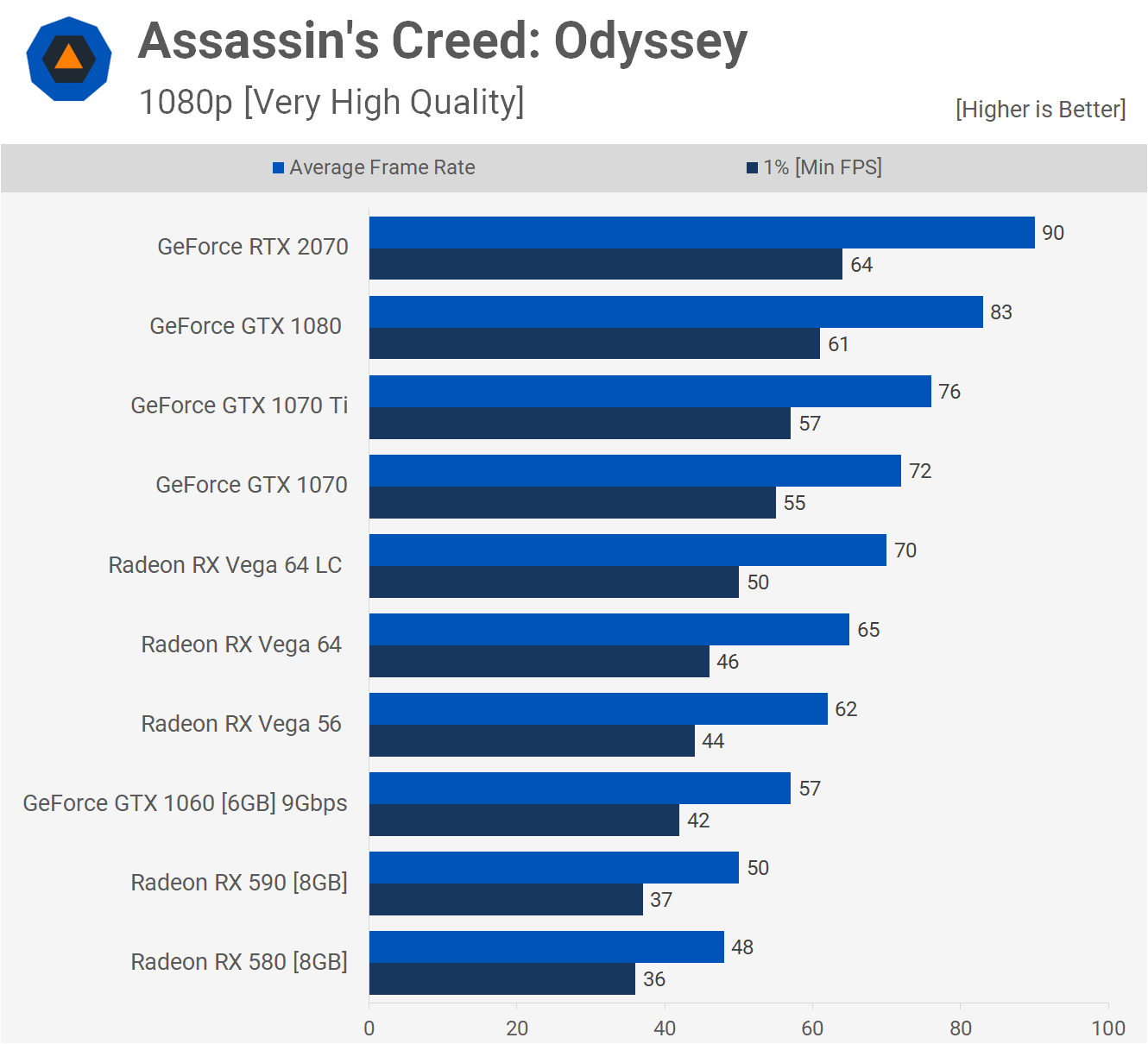
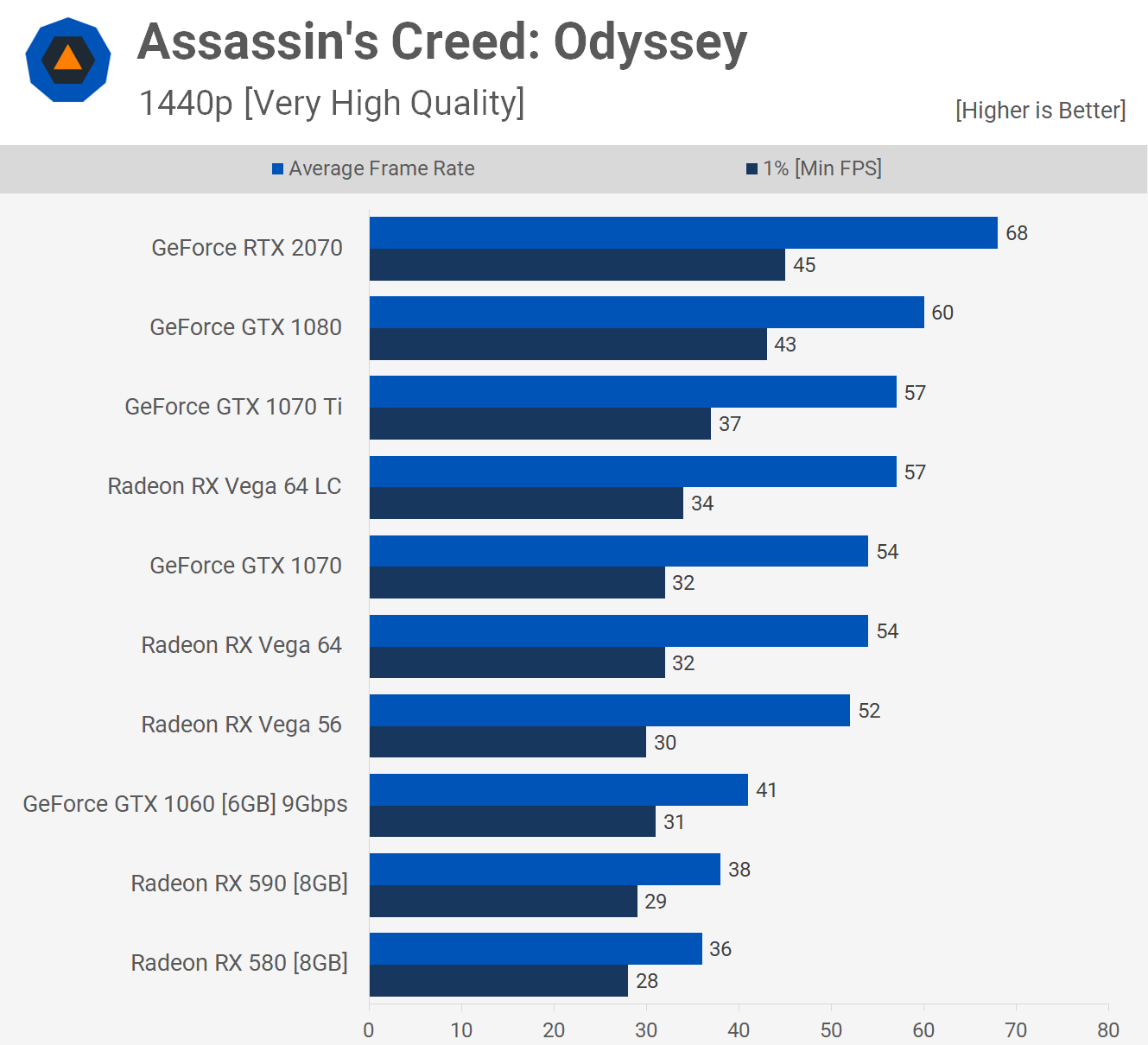
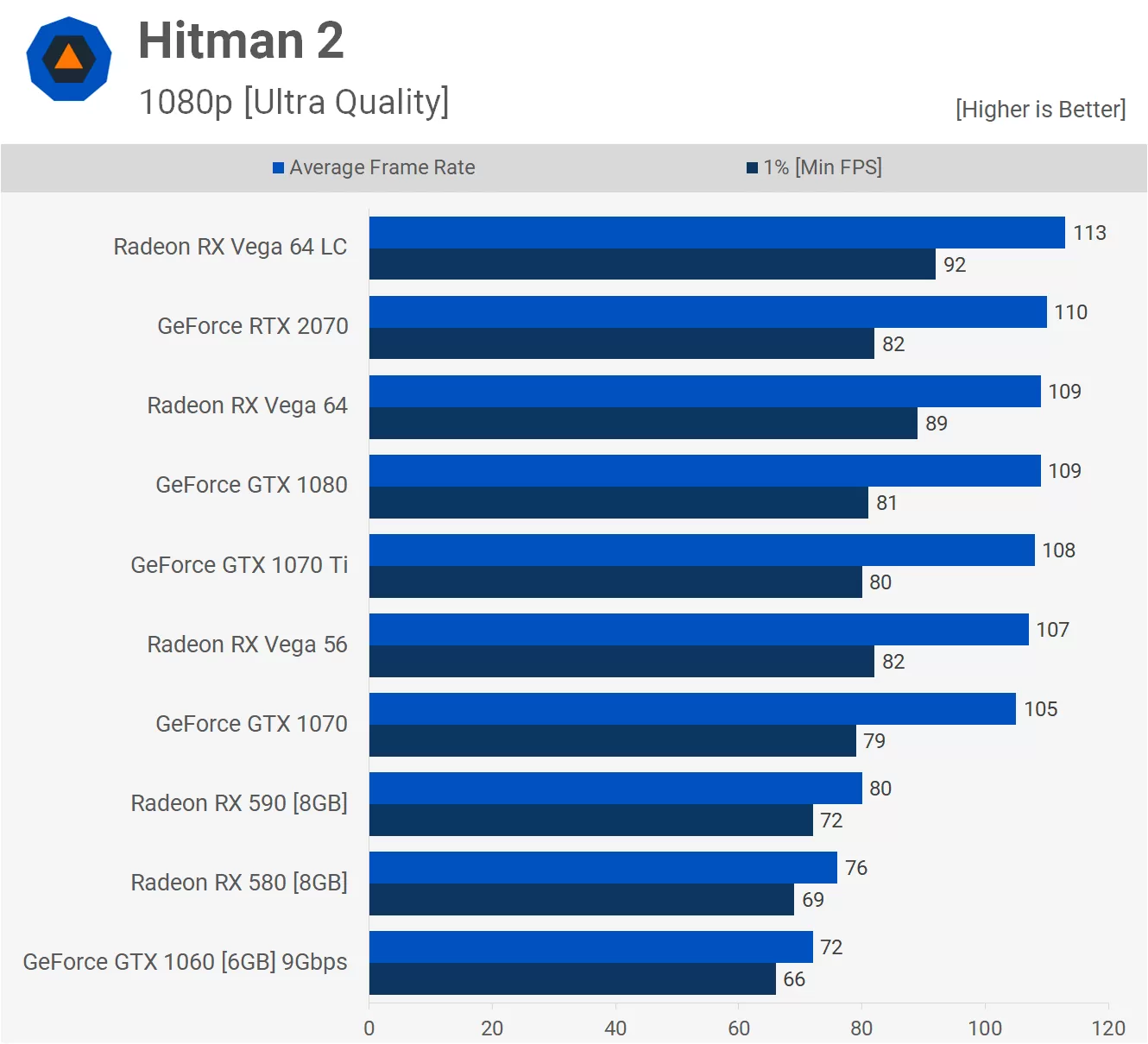
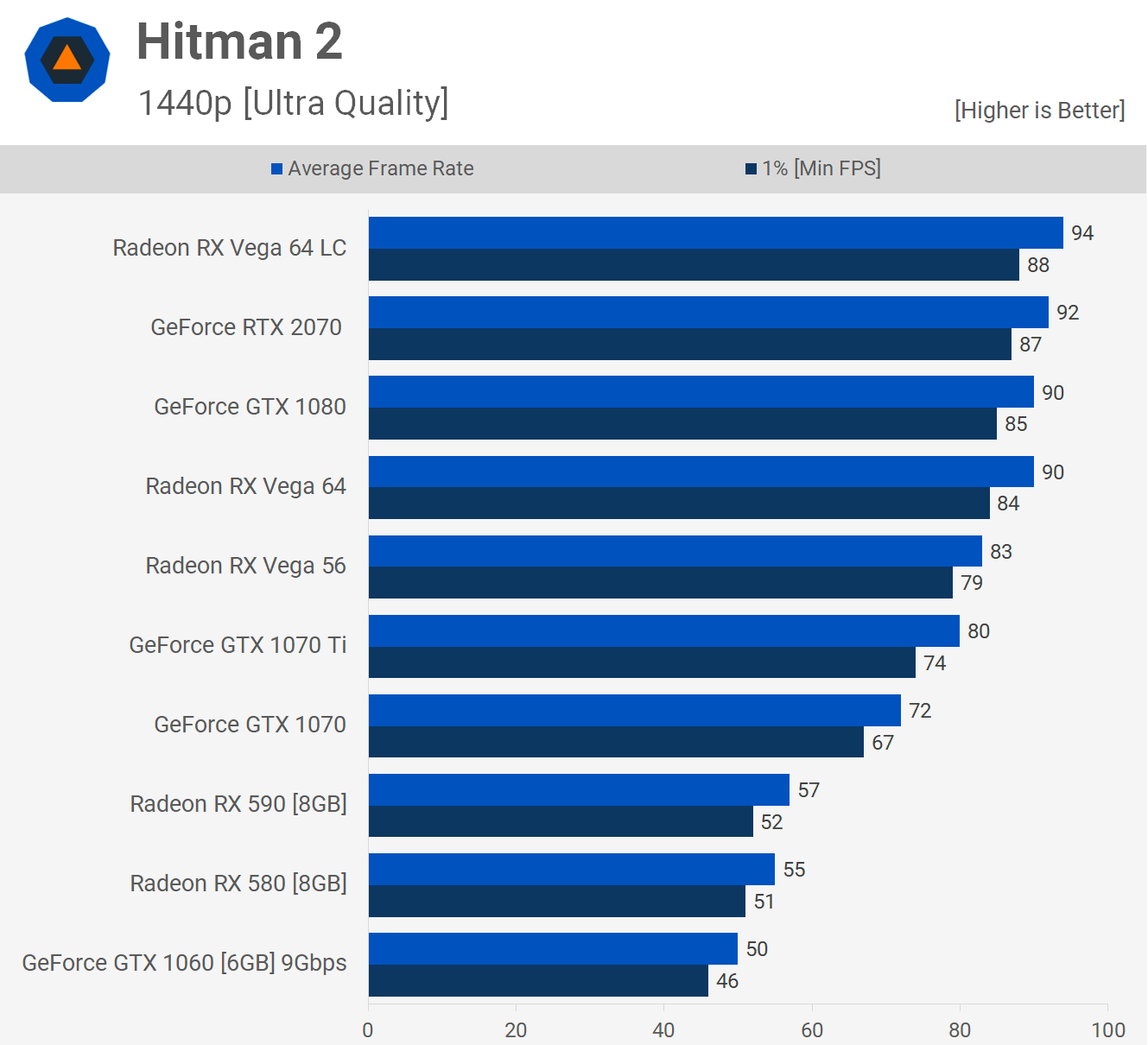
This is our first time benchmarking with Hitman 2... shame it's not a more exciting occasion. Hither the RX 590 offered a 5% performance bump over the 580 and that meant it was eleven% faster than the 1060 at 1080p. So at 1440p the margin between the 580 and 590 is reduced to just 2fps, a 4% performance advantage going the way of the 590.
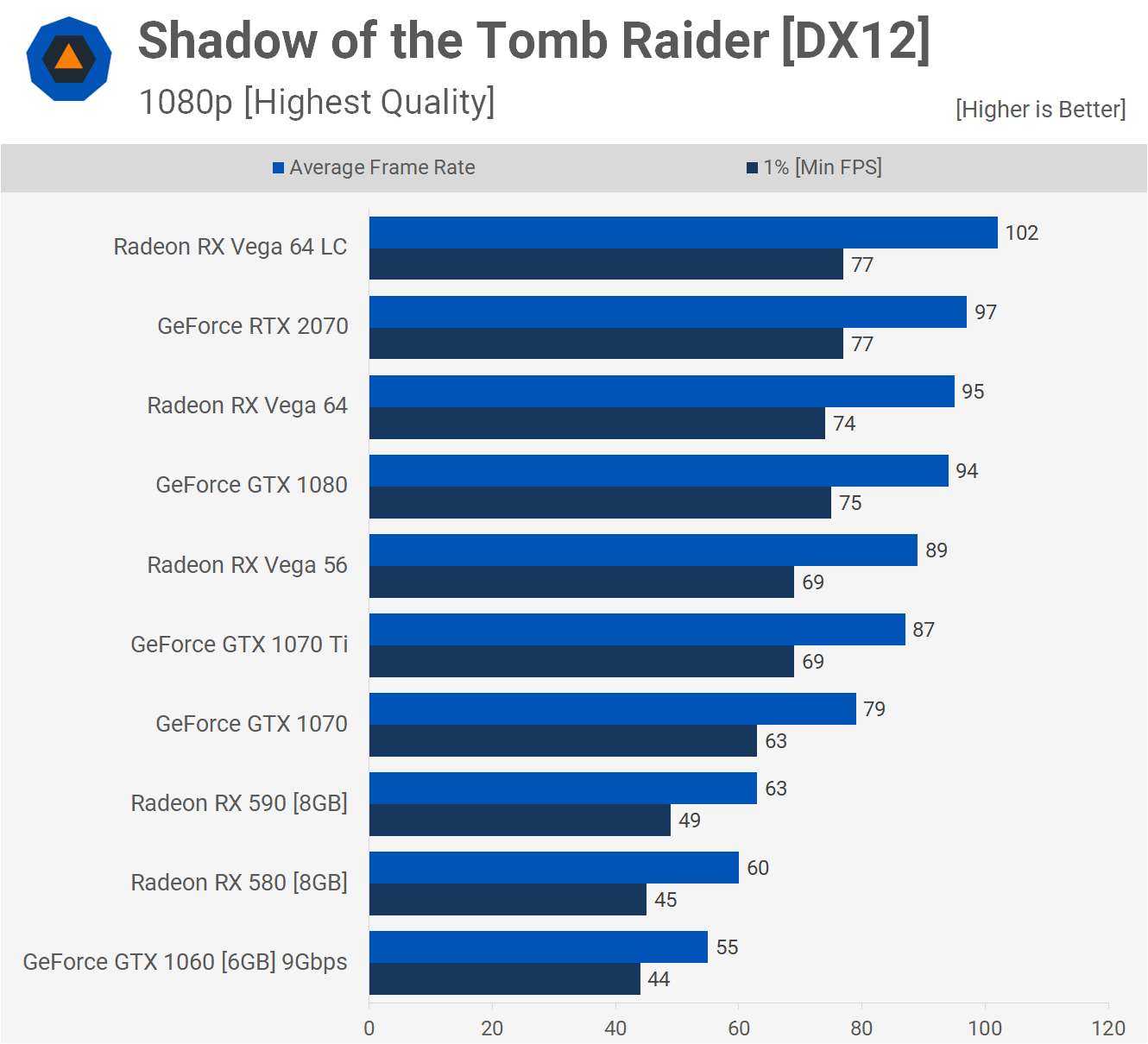
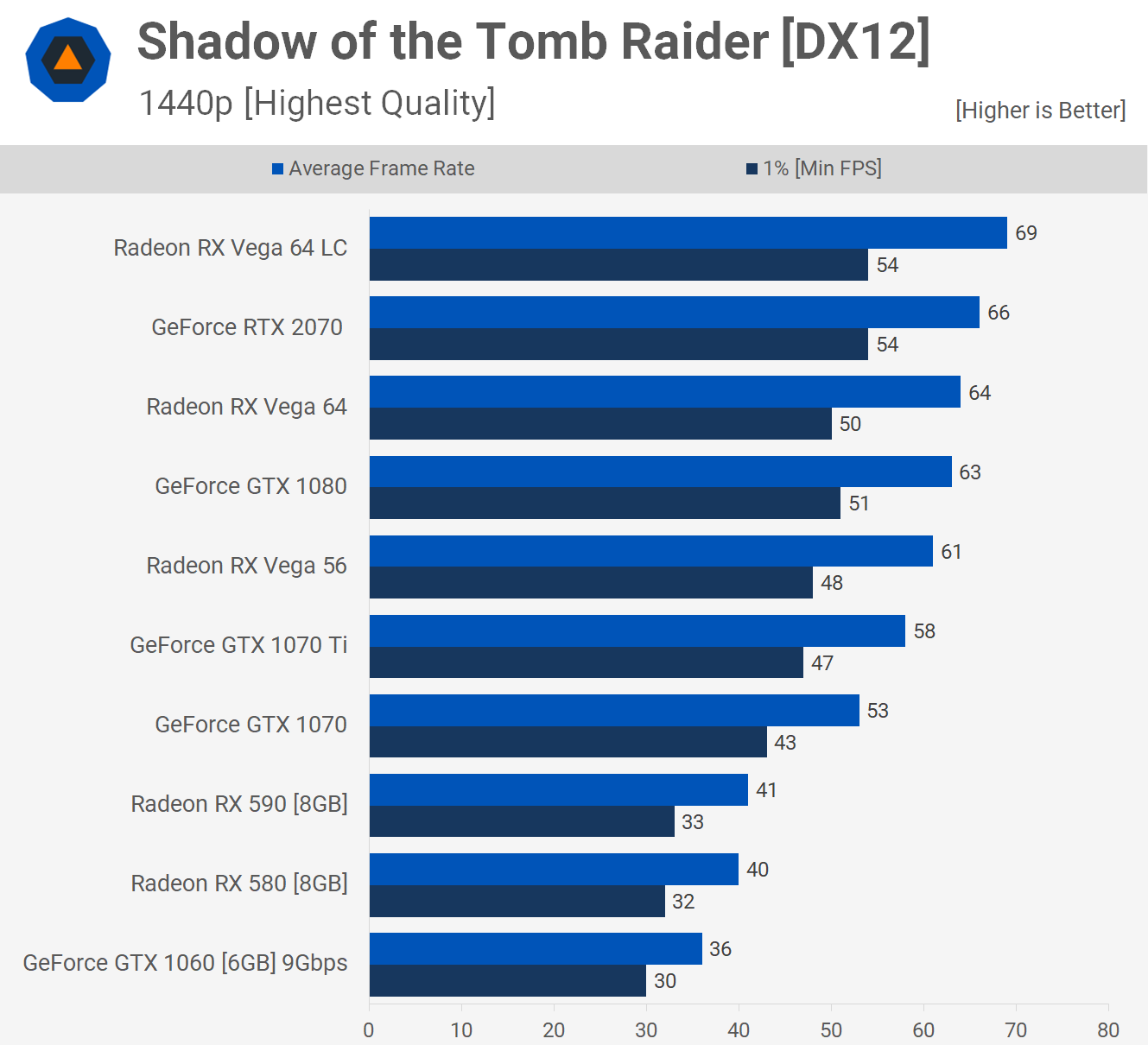
Another 5% performance gain is seen in Shadow of the Tomb Raider, rendering 63 fps on average opposed to the 580's 60 fps.
At 1440p we see just a unmarried frame advantage going to the 590, that said it was 14% faster than the GTX 1060.
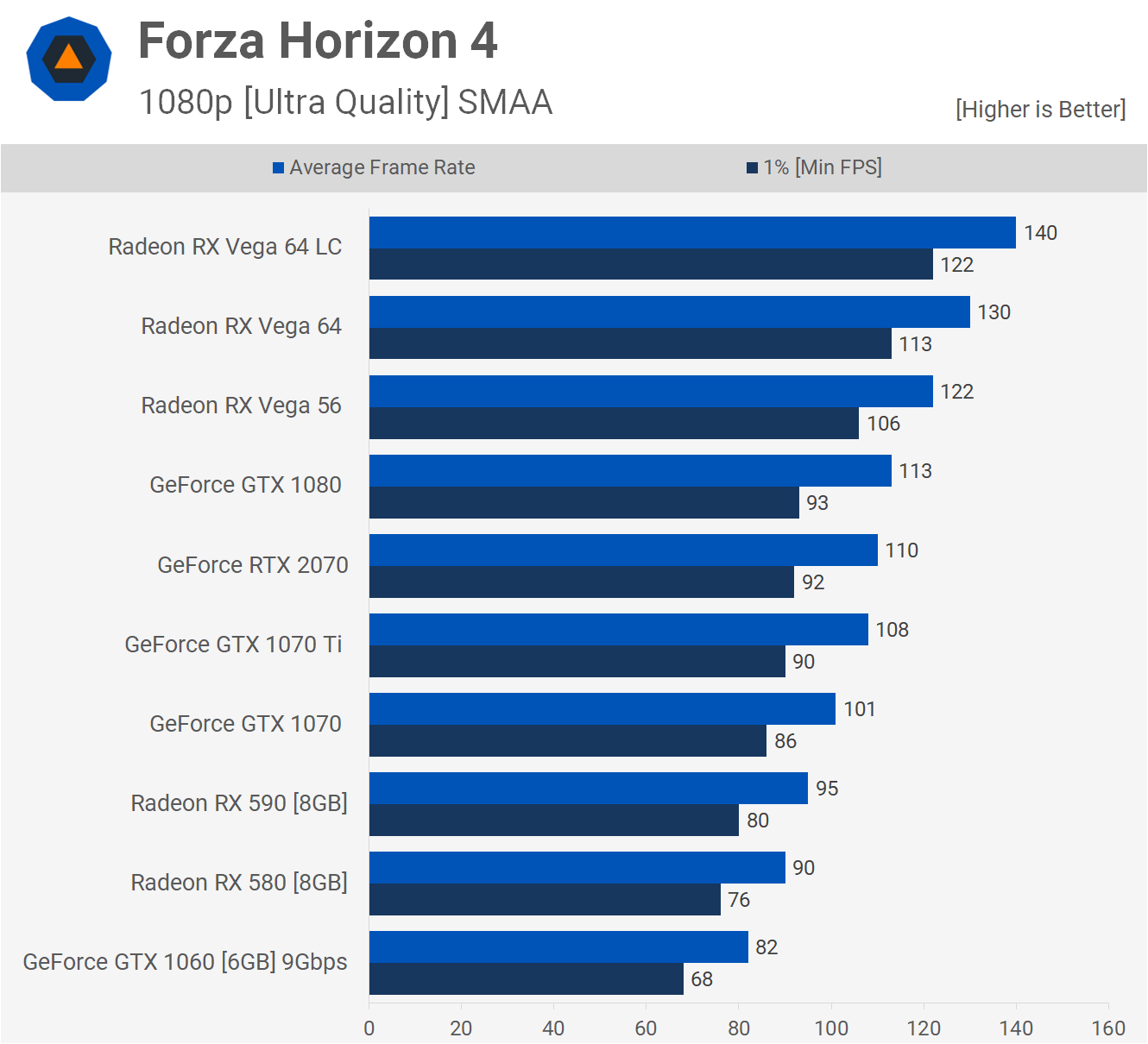
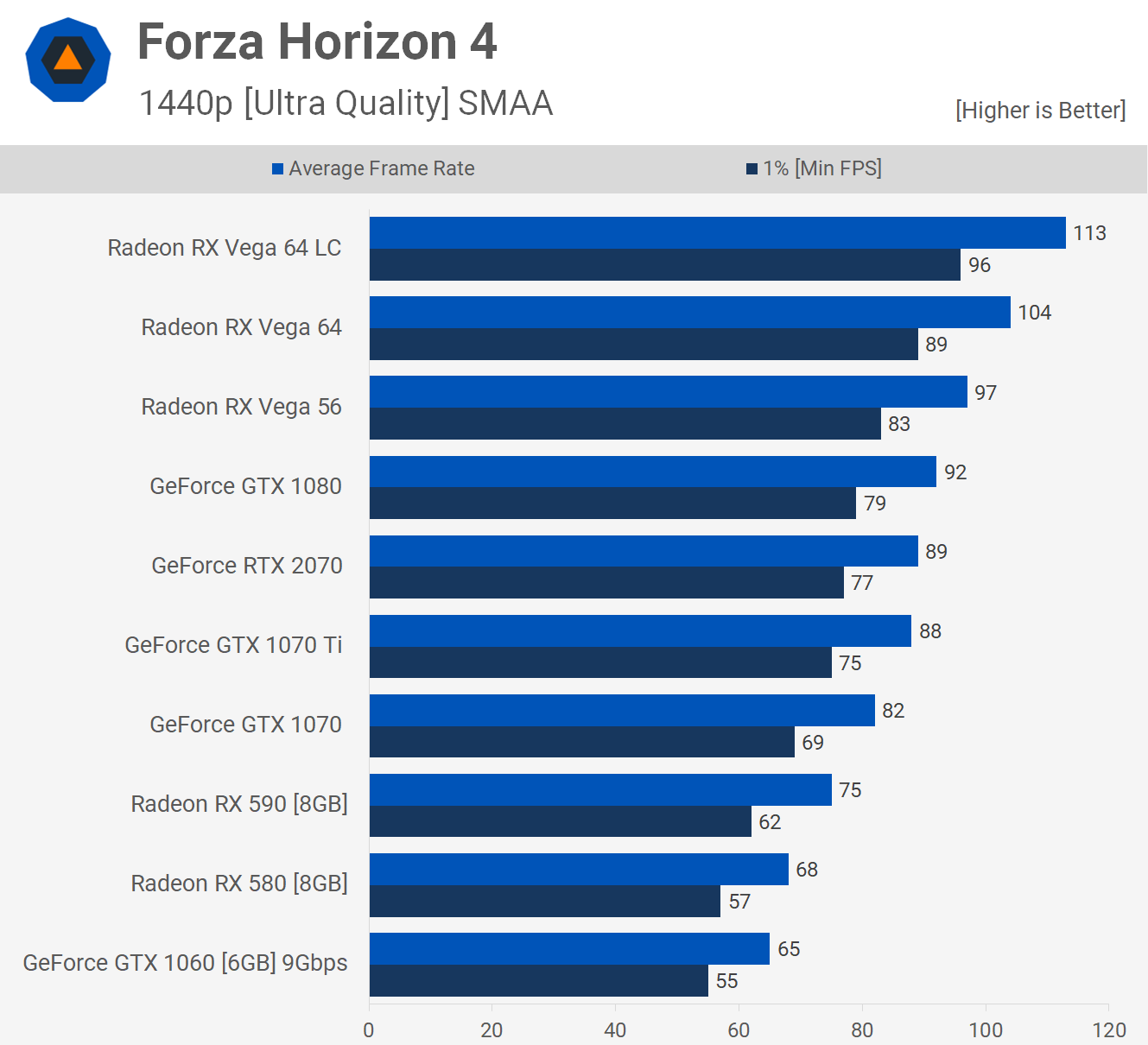
Forza Horizon 4 played really well on the RX 590 at 1080p equally frame rates never dipped below 80fps. Oddly we did encounter a 10% functioning boost at 1440p, I suspect with a reference clocked 580 you'd see more double digit gains and I'll look into this in a moment.
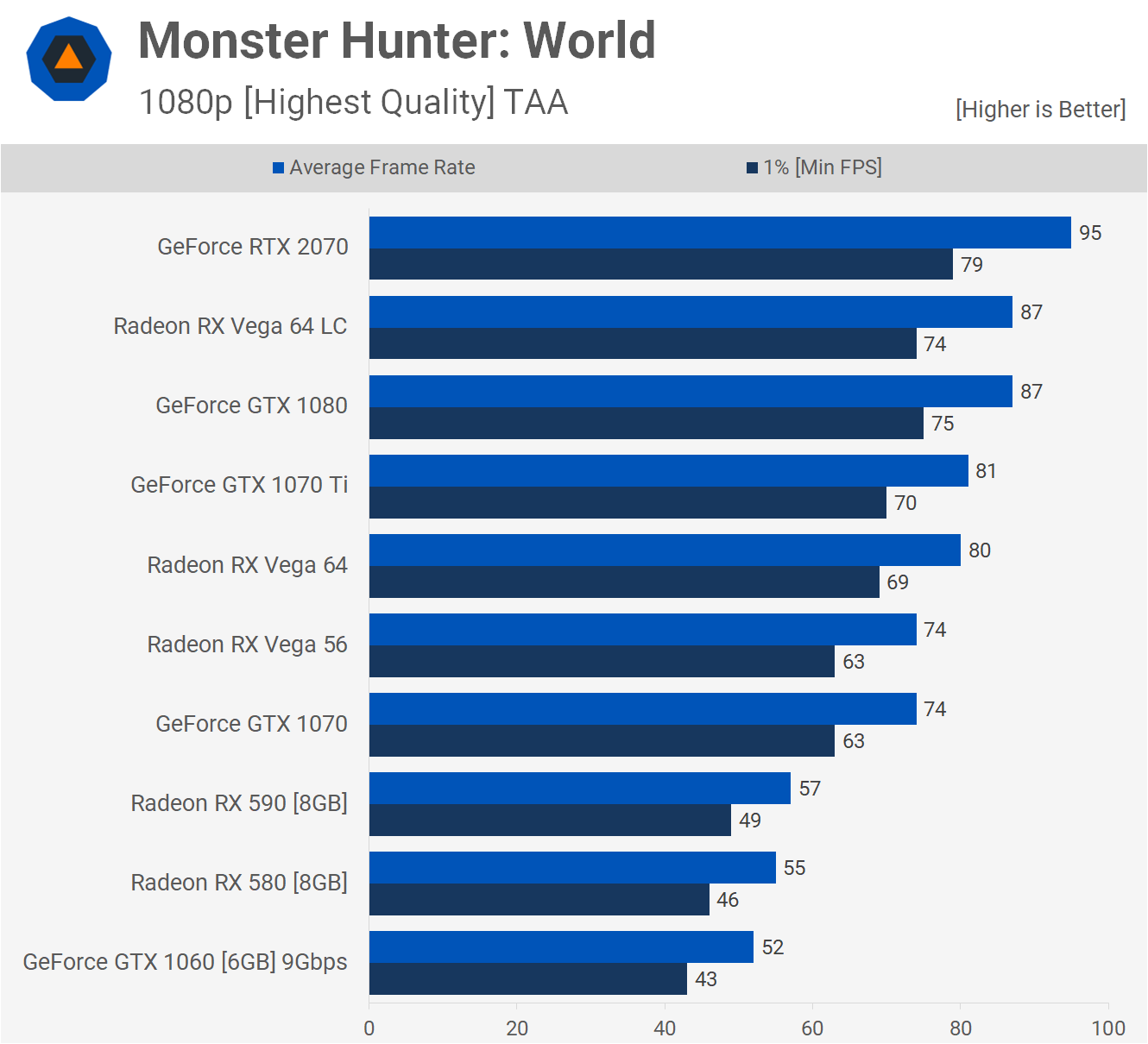
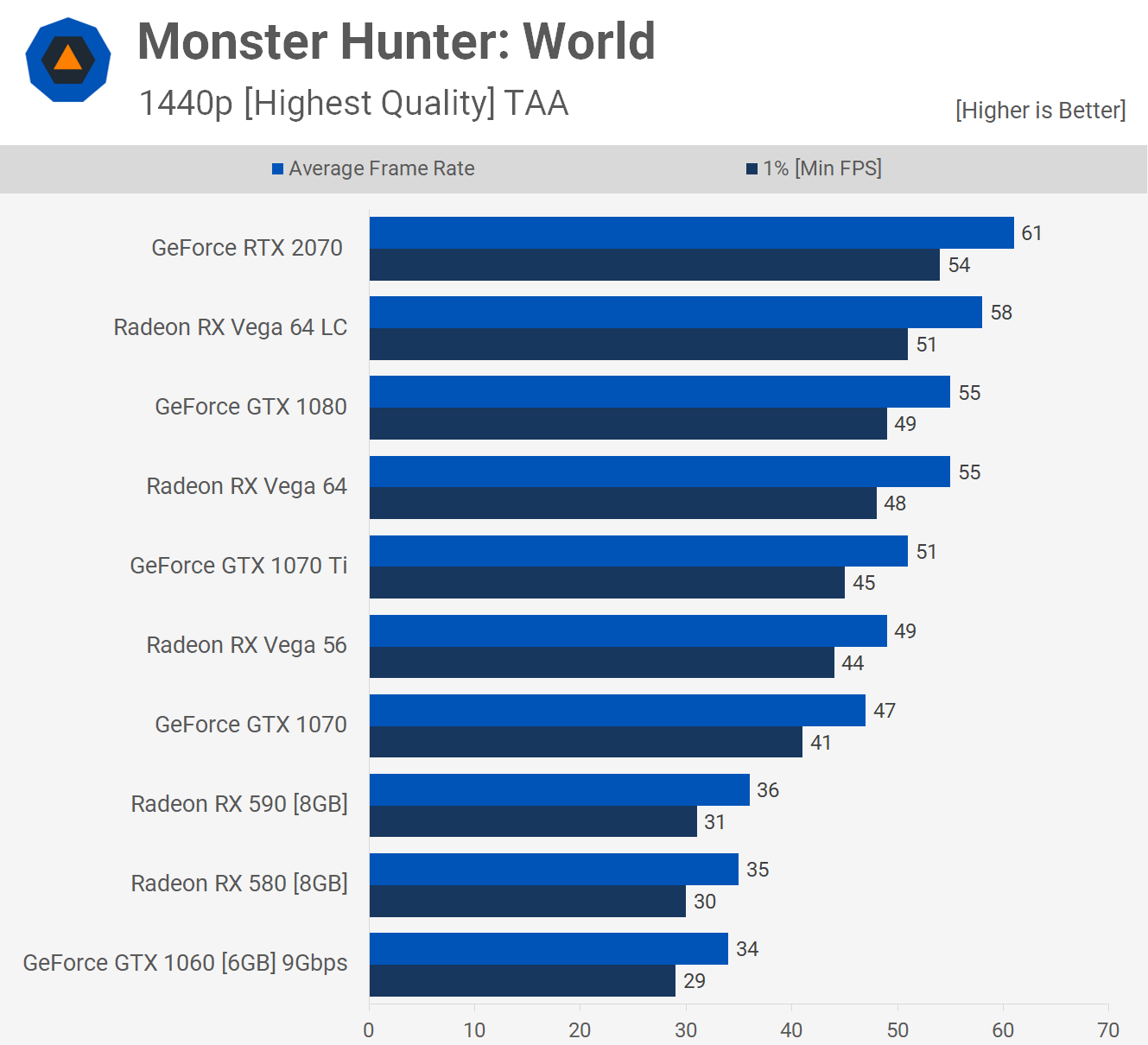
Of the 21 games we've tested the last one we're going to talk over is Monster Hunter Earth. At 1080p we see some other unexciting 4% performance proceeds over the 580, though the 590 was ten% faster than the GTX 1060. Then at 1440p we encounter a single extra frame and I don't know about you, but that's virtually all the single digit gains I can handle in a review.
Overclocking
Overclocking the XFX Fatboy landed us a core clock speed of 1620 MHz with a GDDR5 memory frequency of 2250 MHz, resulting in a transfer speed of 9 Gbps. This boosted Battlefield V 1080p operation past 4% with like gains seen at 1440p.

You volition note that the Aorus RX 580 XTR is a power hungry 580 model, using ~10% more power than a more standard 580. With that said, nosotros see XFX's RX 590 pushing full organization consumption slightly higher, and that resulted in a 42% increment over the GTX 1060 configuration, which is no pocket-size deviation.
Realistically, your power supply won't take an issue with this increase and y'all're not exactly going to notice it on the power beak either, unless you game 24/7. The simply real issue is dealing with the extra estrus that's dumped in your case. If you lot have a well ventilated case and so this is less of an effect, just for budget builds this will heat things up.
Operating Temps
Under load for an hour, the XFX Radeon RX 590 Fatboy peaked at 79 degrees which is reasonable, only also starting to get upwards there. The good news is at this temperature information technology was relatively silent as the fans were but spinning at up to 1380 RPM.
Overclocking actually reduced the temperature to 78 degrees as the fans were now spinning at up to 1600 RPM and here they could be heard over the example fans. The operating book wasn't unacceptably loud and certainly nada similar a Vega reference cooled card.
Putting It All Together, Cost Per Frame
Coming in starting time place by a state mile is the Radeon RX 580. You can currently buy 8GB models for $200 which is a super buy. Not that long ago gamers would have sacrificed a finger for a price like that on a mid-range graphics card.
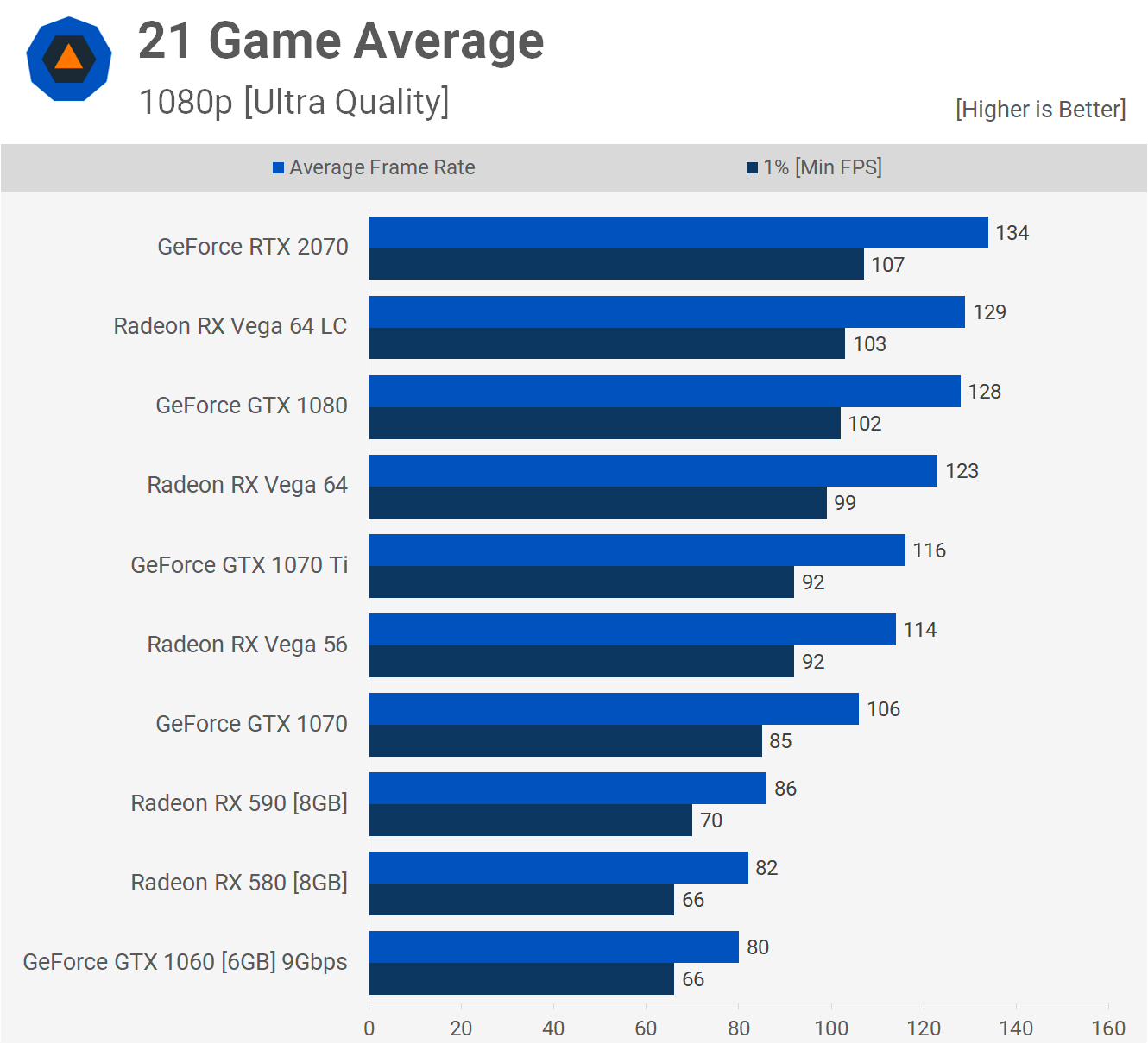
The GTX 1060 is also down at the MSRP, though the 9Gbps models are likely going to cost a scrap more. Honestly they are a gimmick for the about part, we never saw much of a performance uplift over the standard models. In any case, the RX 580 costs 20% less per frame so it'southward the obvious value option. The RX 590 is far less appealing at $280, coming out at a cost of $4 per frame or 32% more expensive on a cost per frame basis. Instead we'd rather spend $100 more and go a GTX 1070 or the 1070 Ti.
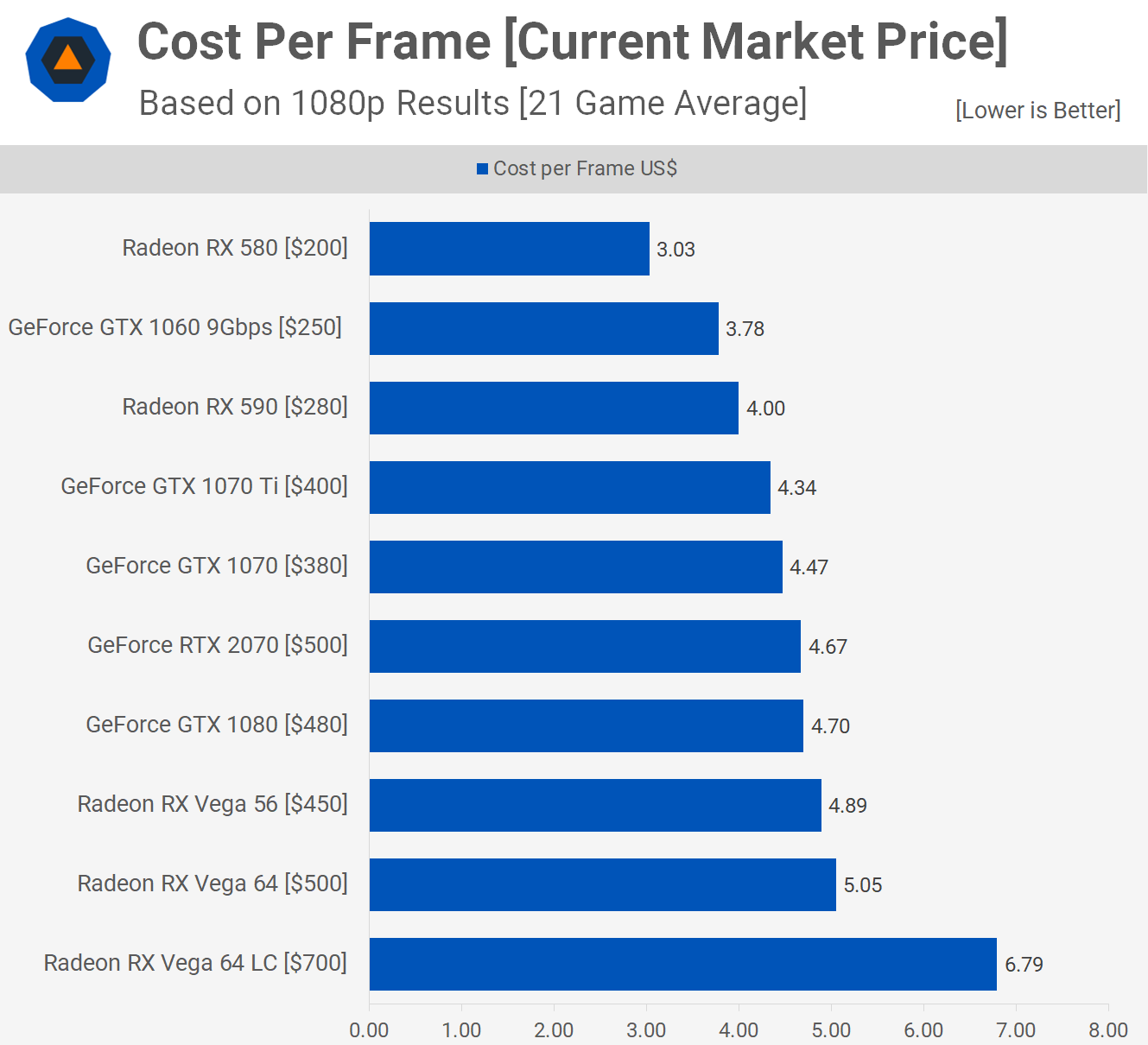
Performance-wise the Radeon RX 590 was always going to be unexciting -- a mildly overclocked RX 580 is just going to take you so far -- but pricing is what'south killed this offering. We're just hoping this is a situation where AMD introduce it at $280 then axe pricing downward to a $250 street price before the year is over. At $250 it matches the GTX 1060 while offering superior operation. Given AMD's current position in the GPU market they demand to offer compelling options and that's what a $250 RX 590 would be.
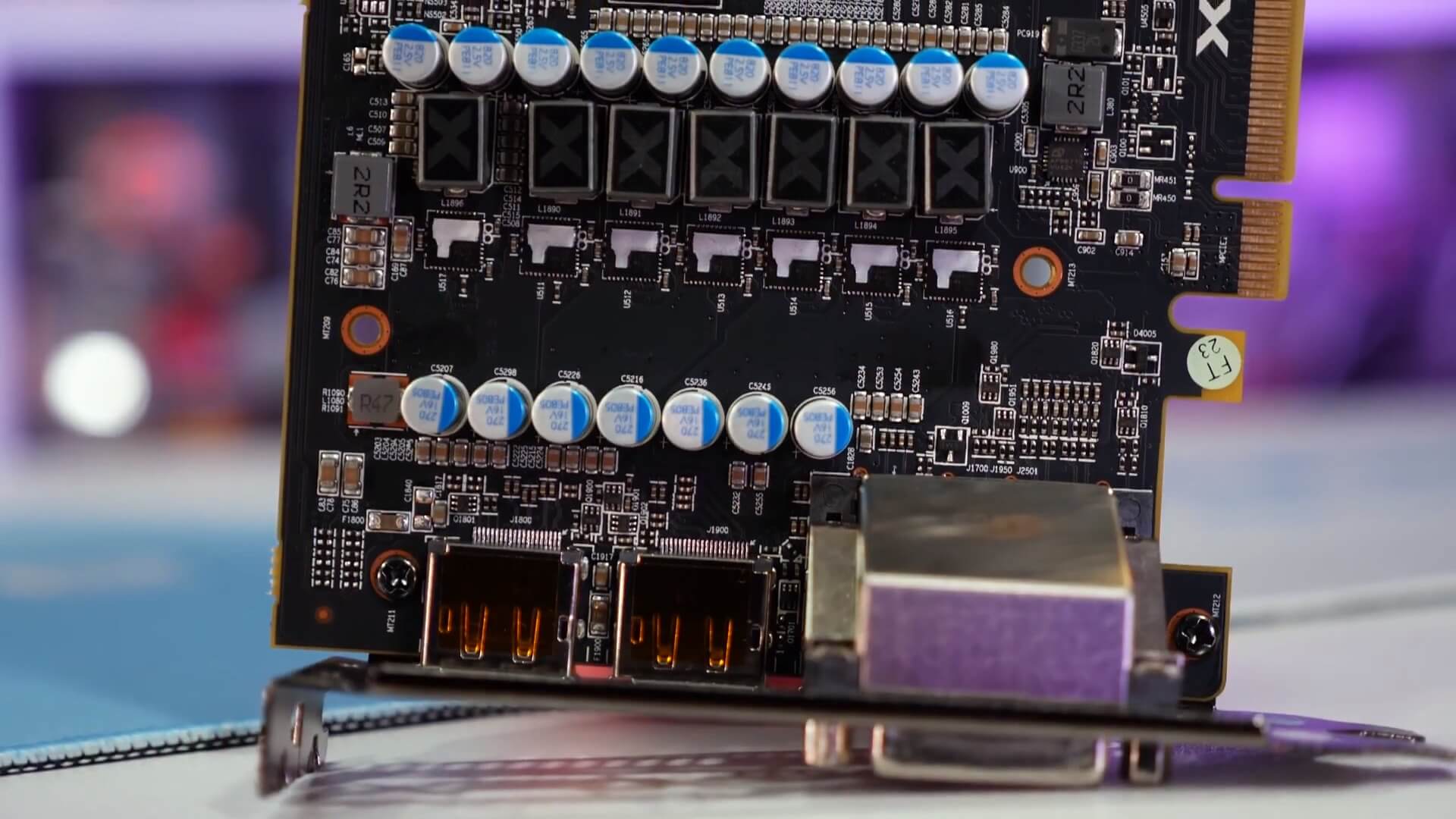
The RX 590 might swallow more power and while not platonic, it makes upwardly for that with a healthy ecosystem of affordable FreeSync monitors and an extra 2GB of VRAM. Merely as a mid-range value offer, its biggest trouble is having to be sold alongside a $200 RX 580. And the biggest problem the RX 580 faces is the $150 RX 570, and then it appears AMD is AMDying themselves...
Lesser line, the RX 590 is not a bad production, it's simply got the wrong price sticker. If you're in the market place for a new graphics carte du jour these holidays, in that location are enough of GPUs on offering at bonny prices which is a welcome change from where we were a year agone.
Shopping Shortcuts:
- Radeon RX 580 on Amazon, Newegg
- GeForce GTX 1070 Ti on Amazon
- GeForce GTX 1060 6GB on Amazon
- Radeon RX 570 on Amazon
- GeForce RTX 2080 Ti on Amazon, Newegg
- GeForce RTX 2080 on Amazon, Newegg
- GeForce GTX 1080 on Amazon, Newegg
Source: https://www.techspot.com/review/1747-amd-radeon-rx-590/
Posted by: conleynotartinge.blogspot.com


0 Response to "Radeon RX 590 vs. RX 580 vs. GeForce GTX 1060"
Post a Comment